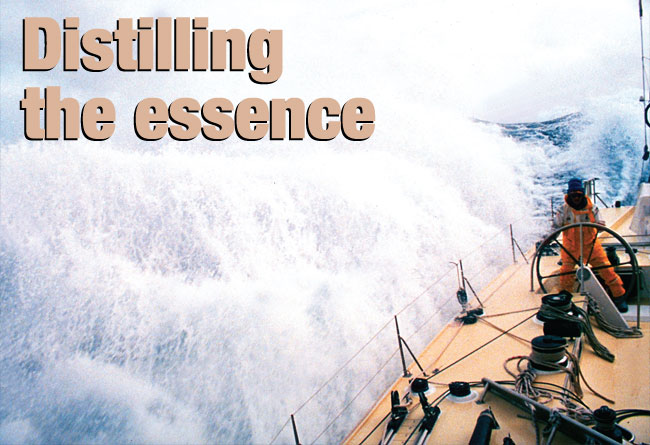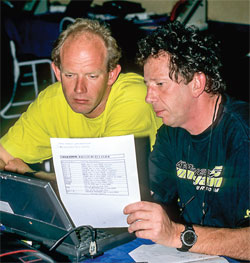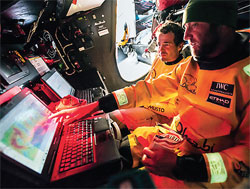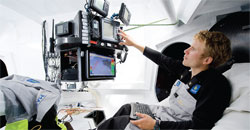

Blue Robinson talks immovable objects, round-the-world navigation and Southern Ocean eather with routeur du jour Marcel van Triest
Seahorse Magazine: Before the last Volvo Ocean Race when Ian Walker on Abu Dhabi came to you, what was your brief?
Marcel van Triest: I discussed this with Ian not so long ago, asking what his philo - sophy was in getting me and Chris Bedford involved. Ian’s take on it was that if he took a blank sheet of paper and asked where he could become better with the resources that were available to him – as the VOR is now one-design, which doesn’t allow two-boat testing or new areas in sails to explore – one of the areas he identified where money and people could improve his campaign was navigation.
He then made a clear goal of trying to get the best he could, and the brief to Chris and me was not to focus on a certain area but to assist them by leaving no stone unturned. And that is really how I approached it, preparing the legs as if I was going myself, but with the benefit that I wasn’t and so I could really drain myself and be worn out by the leg start.
With navigator Simon Fisher some of the tasks we doubled up on, as simple as the two of us checking waypoints in traffic separation zones. I recall when the fleet were leaving Holland these got amended at least 11 times, meaning it is very easy to make an error. If you have somebody in the team administration checking this it just isn’t the same as another navigator. Plus you have all the Notices to Mariners, which is a big read if you are racing through different nav areas; all this can get away from you if you are on your own.
Me doing it all allowed SiFi to rest, take part in sponsor commitments and spend time with his family, knowing that everything was in hand.
SH: Are there various levels of support you offer – exclusive 100 per cent commitment to a team or advising on individual legs?
MVT: That would not be my preferred solution, because I become part of a team and the relationship is fine-tuned as things evolve. At the beginning of a project people are getting to know each other. Then over time things become more efficient, and so one-off advice for a single leg is possible, but I don’t think as effective. I have found in my routings that experience and common history pay off. I have had a long relationship with Banque Populaire, and before that a decade working with Franck Cammas and Groupama. The second Jules Verne attempt with Idec we just completed was so much easier than the previous time – from all our perspectives.
SH: With someone like Abu Dhabi, how do you structure your day?
MVT: With the VOR there is no outside assistance which simplifies things. This means the week leading up to the leg start with Ian’s team there were many nights I had no sleep at all. If the weather is complicated and there are big choices to make right out of the gate, I want to double and triple-check things and access new models as they come in. With Abu Dhabi and Chris Bedford we had a morning and evening briefing when often Chris and I would be shooting holes in each other’s theories, and SiFi was witnessing this – observing two knowledgeable people discussing options. Plus we always look at scenarios where a certain option doesn’t pan out, which would then generate a conversation leading Chris to focus on a particular meteorological problem while I would work more on the strategy.
All this meant SiFi could start the leg with all the information, the checklists and key points, so there was nothing new about critical decisions at key moments, including which information did he have to update onboard at which frequency to make a certain decision. A typical scenario would be that something is a 60/40 call in six days’ time, but he has to be aware of the factors that are driving this, and he should keep his eye on certain influences to see that it evolves into an 80/20 call as it should. SiFi summed it up when he said he felt both extremely ready and extremely well prepared to do the leg. When you run a lot of routes it becomes clear what the key decision moments are on that leg. To get to this stage, where you’ve distilled the essence out of it, takes time, and if someone does this for him SiFi can stay rested.
SH: You have been shoreside support for some incredibly successful campaigns, most recently Idec. What sort of level of certainty are the models giving you now?
MVT: It depends which ocean basin you are in and the timeframes. For the RTW multihull I usually look at the time to Cape Town for the decision on when to go. This means looking at an 11-14 day window, where it gets a bit fluffy at the end.
SH: Do you always trust the models?
MVT: There is a trend and I have a very probability-based approach. Say if you see a trend developing and you see that going your way in the six and 12-hourly updates, you can begin to believe that. If you think about the window we didn’t take with Idec, which was the day the Vendée Globe started and Thomas Coville [Sodebo] left, the reason we didn’t go then was because for me it was a very binary solution in the approach to Cape Town, with the St Helena High far south and the ice far north, giving a very narrow lane to sail between the two – if at all. If that lane is not present either you park in the high, or you start taking significant risks with the ice. To me, at that stage on 6 November – which was still early in our standby window – either it is relatively OK-ish, or it is a complete disaster. So it was too binary and I advised Francis [Joyon] not to go.
If you followed Thomas Coville’s record he said that he identified a no-go zone at 43°S, giving him a lane 75 miles wide where he gybed multiple times in 24 hours. He did sail into the no-go zone that he identified, but his sponsor Sodebo had the budget to purchase additional satellite images to assist him with this. Actually, his time to Cape Town was not very fast, and had Idec left at the same time we could have been only half a day ahead of him, so that panned out pretty much as I expected.
When people criticised us on why we didn’t go then, those comments were very much based on Coville’s excellent Southern Indian and Pacific Ocean performance. His time to Cape Town was good for a single hander, but would have been only mediocre for us on a fully crewed Jules Verne attempt, plus getting there with significant danger of losing two or three days if the St Helena High was now 60 miles further south. In contrast, when we left on the 10th, on Idec’s record-breaking run we had a pretty average time to the equator and a relatively slow south Atlantic, but knew from the start we had an 800-mile window wide open under South Africa.

SH: And then?
MVT: Then we were lucky and got completely in phase with a low that was behind us, the perfect timing of which I didn’t see when we started the attempt. If you talk about a two-week window you can have a significant certainty on the St Helena High and how that is ridging under Cape Town, but the timing of a low coming off the south Atlantic Rio de Janeiro cold front is more uncertain, as this can be a day sooner or later or not happen at all. So for some things you have high proba bility 10-14 days out; some things you know will happen, but with less accuracy on the timing.
SH: The VOR is heading back into the Southern Ocean on leg 3 to Melbourne. What are the big issues on this leg?
MVT: Firstly, it depends on how the VOR will deal with the ice. When Sodebo and Idec were in the Southern Indian Ocean ice was as high as the Crozet Islands. But the VOR is a year on from that observation, so we don’t know.
It is a fairly typical scenario to have ice in the approaches to South Africa pretty far north, as you have a cone of ice, with some getting away from that cone and drifting into the Southern Indian Ocean.
If you look at Antarctica there are two main sources of icebergs, the Weddell Sea and the Ross Sea – those are the two main iceberg factories. How it works out on the Cape Town-Melbourne leg is too early to say, but with Banque Populaire we had quite a bit of ice under Australia, which I haven’t seen since, and this time around after Crozet, coming into the Kerguelens, it started to fall away to the south.
It also depends on how safe VOR want to be. Do they want to ensure no one sees any ice? Also relevant is how much money you put into this – the more you look, the more you find. In the last VOR one study was done that advised that the Pacific leg was clear of ice, but with further research commissioned by Knut Frostad icebergs were located, some over 1km in length, so the exclusion zone was positioned around the new data.
SH: In 1997 Swedish Match had an amazing jump out of Cape Town… is that still possible?
MVT: It is always possible. It can be tricky leaving Cape Town if there is a situation where the St Helena High is ridging in. After 40 or 41°S it becomes more of a drag race, then the ice gates or whatever VOR choose will have a big impact. Exclusion zones give you the most water to play with, but if they choose to go back to ice gates the chances of a jump on other boats increase. The last Barcelona, VOR and Vendée used exclusion zones, and this gives you clearly defined no-go areas as opposed to an imaginary gate that is pretty far north, causing the boats to loop between the gates. In the Southern Ocean I don’t think there is a big opportunity to get away – it did happen to Armel and Alex in the last Vendée so it’s not imposs - ible, but it’s not likely.
SH: At the end of that leg 3?
MVT: Well, you can get fairly big differences in the approaches to Melbourne, with the Australian Bight high pressure which can ridge into the Tasman Sea.
SH: Leg 3 is double-points, and relatively early on in the race; with that in mind how important is shoreside support with someone like yourself now for teams?
MVT: I would like to think very important as that increases my value! This support is just a cog in the overall machine. But to give you one example of what this type of shore support could lead to, in the last VOR leg out of Lisbon I went through all the Notices to Mariners, and there was a surveying operation happening, towing ten 10-mile cables, with nine guard ships plus plenty of support vessels all steaming in a pattern. I was aware of this and kept track of its pattern for 10 days or so.
The morning the fleet left Lisbon this surveying flotilla was south of Porto, so I gave SiFi their latest position and heading and when I thought they were going to turn. The reality was the VOR fleet didn’t get close to the surveying operation, but if they had SiFi would probably have been alone in being aware of the size of the flotilla in front and having a plan, which could have been a leg winner. This is what I mean by leaving no stone unturned.
SH: And other obstacles…
MVT: With Idec I occasionally gave them positions of oceanographic buoys – which they had no idea were out there. These are not on any chart and after I sent an image of one to Francis, he said, ‘This is really dangerous, they are like small icebergs!’ He was off Brazil at the time and said, ‘No doubt some small sailing boats have been lost in the name of science…’
SH: Fascinating – and frightening.
MVT: So if you hit one of these steel buoys when you are doing 35kt you have an issue. If you look at the number of buoys floating around the world at a set depth, say at 1km down for a week then down to 2km then to the surface, it’s scary… there are over 100 of this type alone. I sent a screen shot to Idec of all the oceanic observations carried out in December from this kind of buoy, and it is a pretty dense pattern around the world. And these are not accounted for, they are drift buoys and just pop up at random. If you hit one with your foiling monohull, that is a UFO.
SH: The next VOR Southern Ocean leg is Auckland-Brazil, starting in March 2018…
MVT: Departing from Auckland on 18 March puts the fleet at the Horn around 1 April, which is late, though the issue of ice will not significantly change. In your approach to Cape Horn the ice tends to thin out – again you have a cone out of the Ross Sea and chunks drift out of that cone towards Cape Horn; but the closer you get the less dense it gets. My main concern is approaching Cape Horn late in the season means an increased risk of bad weather…

Two sides of the same coin… Abu Dhabi skipper Ian Walker works with Roberto ‘Chuny’ Bermúdez de Castro at the sophisticated combined nav/media station in the 2014/15 Volvo Ocean Race (above). In practice the tactical options in the last race proved narrow as the one-design nature of the VO65 fleet led to cautious strategies, the frontrunners relying on speed rather than radical routing once they confirmed who was fast and who was not. All the same tools in a more compact package for Vendée Globe winner François Gabart on his Imoca 60 Macif (below). The Imoca rule minimum weight… there isn’t one

SH: With the fleet so close now, will boats that are not performing well throw the dice more as the race develops?
MVT: I would say less. In the days of the Volvo 70s, if for instance you were up against someone like ABN Amro One you knew that being in the same stretch of water with those guys was useless as they were so much quicker, so you had to do something different to give yourselves a chance. If you have a slower boat you take bigger risks as you know you’ll be last anyway. If you have a one-design fleet there is no excuse and it is more tempting to stay together, as your losses are going to be minimal. If you are not going as fast as the next boat, as a crew you just have to work harder with the same boat and the same sails. Psychologically for a navigator it is a lot easier not to take the risks.
SH: Are you still available as an onboard navigator for the next Volvo Ocean Race?
MVT: (Pause) It’s a hard question that one. I can’t see myself doing a whole Volvo as it has become so intense timewise, but if someone asked if I would do a Southern Ocean leg – well, that would be hard to turn down. To do the whole race? Well, I have done five and that was with the four-year sequence – that means I have been sailing around the world for half my life, or preparing for it, so at some stage you have other considerations in your life.
To do it again would mean starting now, and finishing in around 16 months – that is a very big commitment. Also, it would mean stopping other things; I am doing routing for the Jacques Vabre, there’s a new Banque Populaire, plus a likely Jules Verne trophy attempt. I am under contract with Banque Populaire until 2020. I am also part of the Magic Carpet3 team. So to stop all that for a onedesign VOR, where I think the navigator has become less important and the ‘stay with the fleet’ mentality is common? The latter may change with the VOR considering ‘blackouts’ and less weather data for the navigators, but the rhythm of the race is brutal – I have seen that with SiFi. They get ashore and have a day off, then straight back into commitments and meetings, and part of having me involved is to help with this intense schedule…
SH: Did other VOR teams have the level of your support?
MVT: I was talking to Pascal Bidégorry on Dongfeng who had very little support last time. He said sometimes they left to start a leg and they were still plotting waypoints – they just had no time. And when you look at when the VOR fleet left Newport and how many boats infringed traffic separation zones on that leg to Lisbon, a lot of that is lack of preparation. I’m not saying it is unprofessional, people just didn’t have the time. And this stuff is very hard to allocate to someone in the campaign administration – when you talk about waypoints the margin for error is zero.
In a lot of other areas there is a margin for error; even in engineering and structure you have a safety margin, in navigation there is a massive amount that is binary – it’s wrong or it’s right. You have raced with me on Magic Carpet3, Blue, and you have seen occasions when we have lots of waypoints. Because I do these on my own I always get our trimmer and ex-Volvo sailor Emma Westmacott to proofread these. And to make sure this reading is done properly I always put a mistake in.
This is just another layer of checking, because even I am not 200 per cent confident that I haven’t made an error. Sometimes a mistake is staring right at you on the page but your brain skips over it again and again, so it’s great to get someone to check. SiFi on Abu Dhabi would do the waypoints, and I would do the waypoints, and we put them together. Neither of us ever made a mistake, but if we had it would have shown up immediately.
SH: Round-the-world records have been broken recently by significant margins with boats experiencing remarkably favourable conditions. I’m wondering if it is timely to remind people that extreme weather events do still occur down south.
MVT: Boats, equipment and people are refining and improving in the round-theworld attempts, meaning fewer incidents of sails delaminating or rigs breaking, and this is allowing sailors to push even harder. If you look at the footage of Armel and Alex racing off the Kerguelens, that level of pushing is now considered normal.
But don’t forget the Vendée Globe people were slowing down to avoid lots of wind and Jean-Pierre Dick went through Bass Strait, around 400 miles north of his rhumbline to avoid a storm. It hasn’t become any safer to race around the world and there is still ice in the Southern Ocean; and you would need the budget of a small country to gather the satellite images and check the ice with 100 per cent certainty. And of course within 24 hours everything will have changed.
Regarding weather scenarios, it doesn’t happen much these days but if you had a high pressure sitting towards South America with another high pressure towards New Zealand, and in between those a little tropical low pressure comes down… which is completely insignificant in itself, but the moment it mixes with the Southern Ocean it becomes more aggressive. The really nasty stuff is something tropical getting involved – some mass of warm humid air coming down and getting absorbed into a Southern Ocean low can significantly intensify the low, or more accurately a front. And then you get these little lows that are very deep and windy making for a very confused sea state.
The typical Southern Ocean lows are further south and to be honest are not so hairy; yes, they are large and can throw up a big organised sea state with 50 or 55kt of wind for a prolonged period, but it is manageable. The small phenomena are the dangerous ones…
Click here for more information on the Volvo Ocean Race »
We invite you to read on and find out for yourself why Seahorse is the most highly-rated source in the world for anyone who is serious about their racing.
To read on simply SIGN up NOW
Take advantage of our very best subscription offer or order a single copy of this issue of Seahorse.
Online at:
www.seahorse.co.uk/shop and use the code TECH20
Or for iPad simply download the Seahorse App at the iTunes store


